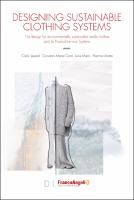Designing Sustainable Clothing Systems
The design for environmentally sustainable textile clothes and its Product-Service Systems
| dc.contributor.author | Vezzoli, Carlo | |
| dc.contributor.author | Conti, Giovanni Maria | |
| dc.contributor.author | Macrì, Luca | |
| dc.contributor.author | Motta, Martina | |
| dc.date.accessioned | 2022-05-31T14:14:24Z | |
| dc.date.available | 2022-05-31T14:14:24Z | |
| dc.date.issued | 2022 | |
| dc.identifier | ONIX_20220531_9788835140115_44 | |
| dc.identifier | OCN: 1371767766 | |
| dc.identifier.uri | https://library.oapen.org/handle/20.500.12657/55776 | |
| dc.description.abstract | The Fashion System is at the center of the international debate as one of the most polluting and most impactful industries on the environment. In the last decade the fashion industry has changed, and is still modifying, its approach, aware of the fact that the attention to the environment can no longer be considered a trend: the entire system needs to find and adopt a methodological approach to the project and to the production of goods and services. Today all the stakeholders on the supply chain follow a path from upstream to downstream: from the treatment of pollution, to the intervention on the production processes that generate a product, to the redesign of products and/or services to reach the discussion and reorientation of social behavior. This path shows the need to intervene in design terms and that the growth in responsibility and role of design, requiring reference scenarios, knowledge and new tools. The book defines the features and scenarios of sustainable development, as well as the evolution of sustainability in research and practice of fashion design, addressing the strategies for the design and development of environmentally sustainable products. The authors describe the Life Cycle Design approach and the strategies and guidelines for integrating environmental requirements into product design for sustainable fashion. They present the so-called Systems of Sustainable Products-Services, namely the most promising scenarios and models to make design for sustainable fashion economically convenient. Finally, they provide a method and related tools to support design for sustainable fashion in the evaluation of the environmental impact of products, with particular emphasis on the LCA (Life Cycle Assessment). The text is enriched by a full-bodied review of interviews and case studies, with the dual purpose of making the design options clear and of highlighting their specificity for the different design contexts. | |
| dc.language | English | |
| dc.relation.ispartofseries | Design International | |
| dc.subject.other | Design for sustainable fashion, Sustainable clothing, Design for Sustainability, Design for Circular Economy, Sustainable Products-Services Systems, Life Cycle Design | |
| dc.title | Designing Sustainable Clothing Systems | |
| dc.title.alternative | The design for environmentally sustainable textile clothes and its Product-Service Systems | |
| dc.type | book | |
| oapen.relation.isPublishedBy | e2ddfb5e-9202-4851-8afe-1e09b020b018 | |
| oapen.relation.isbn | 9788835140115 | |
| oapen.pages | 273 | |
| oapen.place.publication | Milan |

